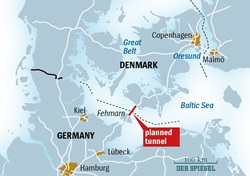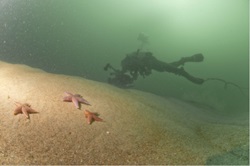The Fehmarnbelt Fixed Link is planned to connect the northern part of Germany to the eastern part of Denmark. DHI is now completing and handing in their background environmental investigations of both a tunnel and a bridge solution. These reports provide crucial information and impact assessments on relevant environmental parameters, giving the iconic project a firm environmentally safe basis, reducing the need for future monitoring and addressing all issues of relevance for the approval process with the environmental authorities.

Once finished, the Fehmarnbelt Fixed Link will constitute the shortest and fastest connection between Hamburg and Copenhagen, benefitting the future economic development in southern Scandinavia and the greater Hamburg area, as well as Europe as a whole.
DHI was involved in most of the background marine and environmental studies concerning the project. They have been carried out in collaboration with German and other international partners, benefitting from DHI´s experience of working internationally across administrative and cultural barriers. All of our environmental studies are now being finalised and handed over to the client, Femern A/S. DHI will also assist Femern A/S in preparing  the final environmental impact assessment (EIA) document, summarising all the background studies, due by October 2012. A final decision on the Fehmarnbelt Fixed Link is expected by the Danish and German authorities in 2014.
the final environmental impact assessment (EIA) document, summarising all the background studies, due by October 2012. A final decision on the Fehmarnbelt Fixed Link is expected by the Danish and German authorities in 2014.
Tunnel vs. Bridge .jpg?h=376&w=250&as=1&la=en)
The environmental footprint as investigated by DHI differs a lot between the tunnel and the bridge solution. The most important potential environmental pressure of a tunnel is the sediment spill from handling of 20 Mio. m3 of mainly clay till during trench dredging for the immersed tunnel elements. DHI is working together with the designers on work methods and work plans for the dredging operations to minimise impact during sensitive seasons. The majority of the dredged material will be used to create a new marine land scape in front of the existing Danish coast. DHI has used its expertise in artificial beaches and lagoons to help the designers to plan a harmonic new coast line including zones for beach tourists and protected sheltered zones where lagoons and meadows will create a new habitat for water fowl.
The bridge solution, on the other hand, with its more than 80 bridge piers has been assessed thoroughly for its effect on the crucial water exchange between the North Sea and the Baltic Sea. Moreover, by studying the behavioural responses of migrating birds to existing bridges DHI has been able to estimate both the added energetic costs and the probability of collision that a bridge would impose on the large-scale bird migration through the Fehmarnbelt.
After such thorough environmental as well as navigational investigations, the preferred solution by Femern A/S is now an 18 km long tunnel, carrying a four-lane motorway and a two-track railway.
Sensitive areas
The project is sensitive as the Fehmarnbelt Fixed Link will pass through a so-called Natura 2000 area on the German side and is close to other Natura 2000 areas, as defined by the EU Habitats Directive. “The environmental investigations carried out in the course of this project were very detailed and elaborate. That should save the client a lot of money in the subsequent project phases, as it reduces the need for monitoring and accompanying campaigns”, Anders Jensen from DHI explains.
Our services included baseline studies as well as impact assessments for hydrography, water quality, coastal and seabed morphology, marine flora and fauna and birds. Field data were collected either from three fixed main stations and ten turbidity stations that were set up for this purpose, or during regular monitoring cruises over two years. Moreover, we investigated the sediment transport and developed the met-ocean design basis.
Figures:
Top: Proposed track of the Fehmarnbelt Fixed Link (© Der Spiegel)
Middle and bottom: Environmental investigations were carried out, amongst others, by divers and from vessels using state-of-the-art equipment (© Femern A/S)